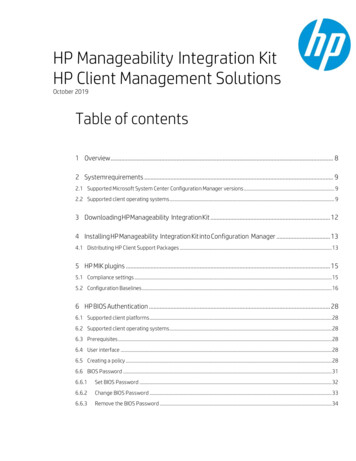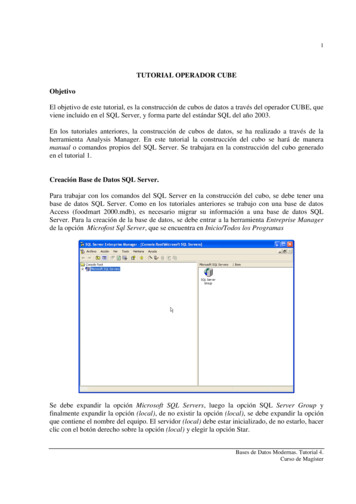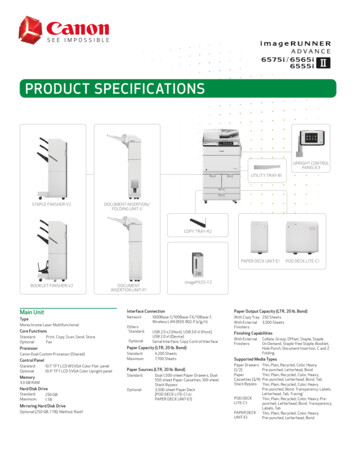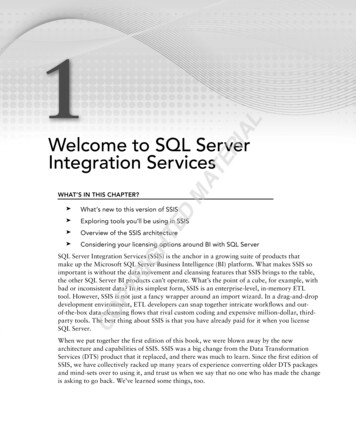
Transcription
Open System Firmware/OpenRMCServer Base ManageabilityGuide for SBSA Compliant Arm(AARCH64) ServersSupreeth Venkatesh, Staff Engineer, ArmDong Wei, Fellow, Arm
Agenda otypeRoadmap/PlanCall to ActionSpecifications
Rationale HARDWAREMANAGEMENTArm Ecosystem Partners value standardized common server manageabilitycapabilities with scope for flexible customizations which add value to theend user.Standardization is key to ensure that Arm Ecosystem does not getfragmented by point solutions that plague the industry today.Leverage industry standard system management specifications includingbut not limited to Redfish, Platform Level Data Model (PLDM), ManagementComponent Transport Protocol (MCTP) as defined by the DistributedManagement Task Force (DMTF).Leverage Hardware Management Specifications and designs as defined byOpen Compute Project (OCP).Specifications
History HARDWAREMANAGEMENTServer Base System Architecture (SBSA)-Hardware system architecture for servers based on 64bit ARM processors.-Standardizes processor element features and key aspects of systemarchitecture.Server Base Boot Requirements (SBBR)-Defines the Boot and Runtime Services expected by an enterpriseplatform Operating System or hypervisor, for an SBSA-compliant ArmAArch64 server.-Based on UEFI, SMBIOS and ACPI specifications.Specifications
History HARDWAREMANAGEMENTARM Enterprise ACS-Architecture Compliance Suite tests SBSA and SBBR ITF-AFVPArmPartnerOSSSpecifications
Introduction HARDWAREMANAGEMENTServer Base Manageability is a specification that is under development inconjunction with partners across the industry.Together with SBSA and SBBR, the SBMG provides a standard basedapproach to building Arm servers, their firmware and their servermanagement capabilities.SBMG is developed within the Arm ServerAC community.Engineering change request process similar to other standards bodies.Anybody in the community can raise a request for a change. Public tocommunity by sending a mail to armserverac-discuss@arm.com Or raisinga public ticket on the mantis DBhttps://atg-mantis.arm.com/Specifications
Introduction HARDWAREMANAGEMENTHelp guide the Arm server designers to provide commonmanageability functions to the end users.To accelerate development of Server Base Manageability Guide(SBMG), three different teams within Arm ServerAC communitywith participation from several different Arm Ecosystem Partnershave been formed.-Reliability, Availability, Serviceability (RAS) team.-Platform Monitoring and Control team.-Remote Debug team.Specifications
Introduction – RAS HARDWAREMANAGEMENTDefine error record formats for RAS errors leveragingexisting common platform error record (CPER) as specifiedin unified extensible firmware interface specification (UEFI).Define the SOC - BMC manageability interface requirementsfor RAS errors including in-band and out-of-band interfaces.Define fault notification signal.Define the interface and mechanism for injecting RAShardware errors.Specifications
Introduction – Monitoring & Control Define interfaces and protocol needed for BMC – SOCcommunication in the scope of Platform Monitoring leveragingOpen Hardware Management Specification for Remote MachineManagement defined by OCP.List of use cases analyzed for Standardizing-BMC to Multiple SOC communication.-BMC assisted SOC power actions.-BMC to monitor critical health of SOC.-BMC to monitor SOC boot progress.-BMC watchdog use cases.HARDWAREMANAGEMENTSpecifications
Introduction – RAS, Monitoring and ControlHARDWAREMANAGEMENT As of September 2019, RAS and Monitoring teams have beenmerged with the common goal of defining interfacesbetween the Soc and BMC.The merged team is entrusted with interface definition forcommunication between Arm based BMC andSatellite/Service Management Controller within/outside ofthe Soc. This is termed as “Soc side band” communication.“Soc side band communication” leverages MCTP transportlayer specifications.Specifications
Introduction – Remote Debug Server Remote Debug is the act of gaining visibility of thehardware and software behaviors of an SoC, using a debuggerwhich is not directly connected to the Server SoC.Define protocols for communicating between the debugger andthe BMC.Define physical interfaces between BMC and SoC.Define protocols for communicating between the BMC and theSoC.Define mechanisms for ensuring only suitable debuggers canaccess the SoC.HARDWAREMANAGEMENTSpecifications
Prototype HARDWAREMANAGEMENTOpenBMC is a Linux foundation project. It is a highly extensible frameworkfor BMC software and implement for data-center computer systems.OpenBMC implementation will be used as a medium to realize Server BaseManageability Guide.Arm and Arm SiPs are participating in the OpenBMC development so thatthere will be an open source implementation to the SBMG requirements.Arm has joined OpenBMC Technical Steering Committee (Arm, IBM, Intel,Facebook, Google & tation
Prototype – Remote Debug Proposed Design proposal is to integrate OpenOCD within OpenBMC 019-July/017122.html OpenOCD is an open source on-chip debugging solution for JTAG connectedprocessors. It enables source level debugging with GNU gdb. It can alsointegrate with and GDB aware IDE, such as eclipse. Completed first phase of implementation which includes the demonstrationof GDB connection on port 3333 to OpenOCD debug server daemon runningon OpenBMC. Next phase of implementation to utilize a wrapper which adds JTAG mastercore infrastructure by defining new JTAG class and provide generic JTAGinterface to allow hardware specific drivers to connect this 2/This will enable all JTAG drivers to use the common interface part and willhave separate drivers for hardware implementation.HARDWAREMANAGEMENTImplementation
Roadmap/Plan HARDWAREMANAGEMENTOpen Compute Project (OCP)1. Plan to contribute SBBR document to OCP.2. Plan to participate in several OCP WGs including but not limited toSecurity, Open System Firmware, Server, Hardware Management, etc.OpenBMC1. Design proposal for remote debug use case, RAS use case (Planned).2. PLDM reviews and contributions.DMTF Standards1. Contribute to PMCI WG specifications.2. Contribute to Redfish WG specifications.
Call to Action Participate in OCP to influence Hardware ManagementHARDWAREMANAGEMENTSpecifications and designs. Participate in ServerAC to help define SBMG. Send an email to Arm (armserverac-request@arm.com). Participate in OpenBMC to enable referenceimplementation and open source delivery option. Participate in Redfish, PMCI and other DMTFWorkgroups.
between the Soc and BMC. The merged team is entrusted with interface definition for communication between Arm based BMC and Satellite/Service Management Controller within/outside of the Soc. This is termed as "Soc side band" communication. "Soc side band communication" leverages MCTP transport layer specifications .











